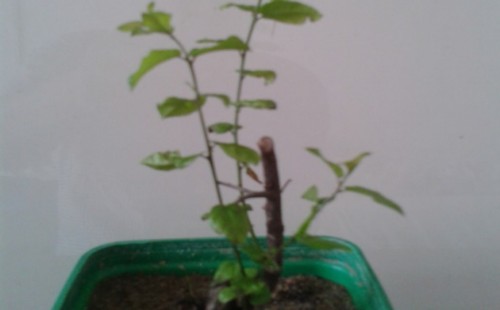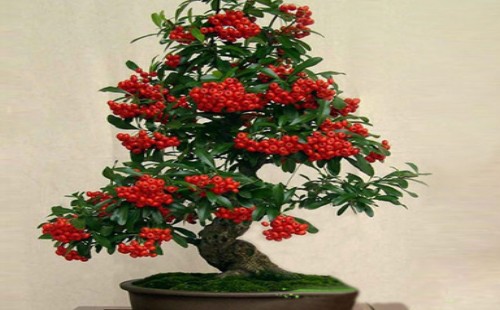When to cut the sparrow plum-the time and method of the sparrow plum cutting
Finch plum has been a high-quality material for making bonsai since ancient times, especially suitable for Finch plum pile landscape. it is not only one of the important tree species for making tree stump bonsai, but also one of the five famous trees in Lingnan bonsai. Sparrow plum bonsai has high ornamental value and good economic benefits, so it has been deeply welcomed by the market. The sparrow plum bonsai can be used to breed seedlings by cutting, and the seedlings can be planted in the pot after leaving the cuttings in bed for more than one year. So, when is the better time to cut Finch plum?

To make sparrow plum bonsai, we must first get the material. As for ordinary users, if it is not convenient to obtain pile scenes in the field or it is more difficult to obtain pile scenes in the field, they often use cutting to cultivate materials. The cutting time of Finch plum is usually better in March in spring or in the rainy season. However, even if the seedlings are propagated by cutting at a more appropriate time, we also need to master certain cutting techniques in order to obtain more satisfactory bonsai materials. So, how to cut Finch plum? Next, please follow the editor to take a look at the cutting method of Finch plum!
First, cutting timing
The timing of sparrow plum cutting often has an important impact on its survival rate, and grasping the accurate cutting time is often the key to the survival of cutting seedlings. Because of the vast territory of our country, the temperature difference between the north and south is relatively large, even in a small range, there will be a large temperature difference. When Finch plum wakes up after dormancy, the sap flow rate in the tree will accelerate and gradually begin to sprout, so cutting strong thick branches before sprouting tends to have the highest survival rate.
2. Cutting cuttings
The health status of cuttings is also one of the important factors affecting survival, the original generally cut off robust branches as cuttings. The bark of such branches is often smooth, and the wood core shown by the cut is mostly dark red. If the bark of the branch is dark brown, it is often attacked by diseases and insect pests, so it can not be used to make cuttings, even if inserted into the culture soil, it is difficult to survive and germinate. The diameter of the cuttings should be within 2.5 cm, not too large, but not too slender, while the length of the cuttings should be kept at 15-20 cm.
Third, cutting methods
First of all, the slotting bed is made in advance, which requires good drainage, mix well with moist mud and river sand in proportion and then use it. After leveling the cutter, you can cut it. However, in order to improve the survival rate of cuttings, it is suggested that the base of cuttings should be soaked in rooting solution for a period of time, and then the excess water should be dried slightly. Then use a stick slightly larger than the diameter of the cuttings to poke a moderately deep hole in the cutter, and then gently insert the cuttings from the base. Finally, gently compact the soil around the cuttings with your fingers.
In the process of cutting, it is generally recommended to use wet soil cutting, which can avoid watering after cutting and have appropriate humidity to maintain the growth of cuttings. And cuttings generally do not directly insert the cuttings into the soil without poking holes, otherwise it is easy to hurt the bark at the base of the cuttings and cause secondary damage, thus affecting survival. And in order to improve the survival rate of cuttings, it is recommended to insert bamboo slices on the cutter and bend the arch to support the mulch. The advantage of covering the film is that it can keep warm and moisturize and avoid excessive evaporation of water.
IV. Plug-in management
After the completion of cutting, it is recommended to choose a sunny day to open the film once a week for spray humidification. If the light is too strong, build a sunshade net on the outer layer in time to keep the light transmittance at about 50%. If the cuttage is carried out in March in Yangchun, it usually takes one month to take root and sprout, and when the sprouting shoots grow to more than 10 cm, we can uncover the film. Of course, we also need to adjust the light according to the light intensity to avoid excessive light and wilting the twigs; at the same time, we should also avoid the lack of light for a long time and affect the normal photosynthesis. And at this time also need to strengthen water spray, spray 3-6 times a day is more appropriate.
Time: 2019-06-06 Click:
- Prev

The shape of Hippophae rhamnoides bonsai
Hippophae rhamnoides is not only rich in nutrition, has a good effect of health care, but also can be used as medicine to treat diseases, is a kind of food and medicine homologous plant. But its function is not limited to this, as bonsai lovers who like to tamper with bonsai, they can even make seabuckthorn into ornamental bonsai. As long as we can make it perfect.
- Next

How to fertilize the newly budded boxwood bonsai
Boxwood bonsai is more afraid of direct light, so it is only necessary to provide scattered light to meet the growth needs in the process of planting and breeding. As for the newly transplanted yellow poplar downhill pile bonsai, it is usually necessary to keep it in the shade for a period of time after successfully taking the pot before transferring to the normal maintenance and management process.
Related
- Fuxing push coffee new agricultural production and marketing class: lack of small-scale processing plants
- Jujube rice field leisure farm deep ploughing Yilan for five years to create a space for organic food and play
- Nongyu Farm-A trial of organic papaya for brave women with advanced technology
- Four points for attention in the prevention and control of diseases and insect pests of edible fungi
- How to add nutrient solution to Edible Fungi
- Is there any good way to control edible fungus mites?
- Open Inoculation Technology of Edible Fungi
- Is there any clever way to use fertilizer for edible fungus in winter?
- What agents are used to kill the pathogens of edible fungi in the mushroom shed?
- Rapid drying of Edible Fungi

